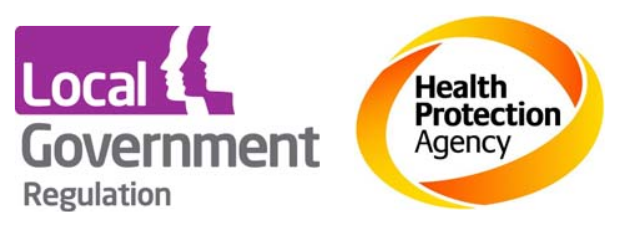Research from the Health Protection Agency (HPA) has revealed that food, water, chopping boards, cleaning cloths and security wristbands sampled from mobile and outdoor food vendors were contaminated with a range of bacteria including E.coli. This bacteria, which originates from human or animal faeces indicates either poor hygiene, undercooking or cross-contamination in the kitchen.
 |
| [relatedPosts title=”Related Posts”] |
|
|
The report ‘A Follow-Up Study of Hygiene Practices in Catering Premises at Large Scale Events in the United Kingdom’ is published on the HPA website today.
Over a seven month period in 2010, 1,662 samples were collected from 153 events by Local Authority sampling officers and tested by the HPA for a range of bacteria including Enterobacteriacae, E.coli and Staphylococcus aureus.
The events where samples were taken included 50 concerts or music festivals, 20 sports events, 39 carnivals, fetes and fairs and 44 ‘other’ events of a type not stated.
Eight per cent of food samples (53/659) were noted as being of an unsatisfactory quality with a further one per cent (seven samples) containing potentially hazardous levels of bacteria including, among others, the presence of Salmonella and Clostridium perfringens. Food poisoning caused by this bacteria most often occurs when food, usually meat, is cooked and then kept warm for several hours before serving.
Of the water samples tested, results revealed that 27 per cent (56/209) contained unacceptable levels of coliform bacteria which can be found in the environment in soil, water and on plants and may also be a sign of faecal contamination. E.coli and/or enterococci bacteria (of faecal origin) were found in 16 samples (eight per cent).
Environmental swabs were taken from chopping boards, food containers, serving counters, utensils, work surfaces and other areas. The study shows that chopping boards had the most unsatisfactory levels of contamination with 60 per cent (84/141) not meeting the required standard. Overall, of 585 swabs from environmental testing 188 (32 per cent) were not of the required standard.
Bacterial levels twenty times what is considered acceptable were found on 56 per cent (97/156) of the cleaning cloths tested. Bacterial contamination is measured in colony forming units with 97 cloths showing the presence of 10,000 colony forming units (cfu) of Enterobacteriacae where the acceptable level is 500 or less. Some cloths also tested positive for E.coli and species of Listeria.
Some events now require vendors to wear a security wristband for the duration of the event as proof of their authorisation to trade. As these are worn permanently it was considered that there may be some risk of cross contamination. Of those tested one fifth (6/33) of wristbands worn by catering staff were contaminated with Enterobacteriacae, E.coli which are all common bacteria found in the human gut and/or Staphylococcus which lives on the skin.
Dr Caroline Willis, a specialist microbiologist at the HPA’s Food, Water and Environment laboratory in Porton Down and one of the authors of the report, said: “Gastrointestinal illnesses are some of the most common problems encountered by people attending festivals and large-scale outdoor events. Various studies have looked at the microbiological standards of food and environments in such locations and although this study showed some improvement in standards of cleanliness there is clearly a lot of room for improvement.
“There are various reasons why hygiene is lower at such events including the volume of customers, use of temporary staff, working in cramped conditions, lack of storage space and difficulties with on-site cleaning. These all combine to lead to greater cross contamination risks which can be increased if levels of personal hygiene are not good.
“Local Environmental Health Departments have done much to improve standards at mobile and outdoor catering premises over recent years but staff need to ensure that both cooking standards and thorough hygiene are rigorously maintained to avoid the risk of people becoming unwell.”
Further Information
- The report can be found here: http://www.hpa.org.uk/webc/HPAwebFile/HPAweb_C/1287144844852
- E.coli bacteria are only found in the human or animal gut. Contamination with E.coli could have occurred by caterers not washing their hands after using the toilet or by cross-contamination from raw meat that becomes contaminated with faecal material in the abattoir.
- Species of Enterobacter can be found in the environment and are also part of the normal flora in the human intestines. The presence of Enterobacteriaceae are indicators of poor hygiene but not necessarily of faecal contamination. They may indicate cross-contamination from raw salad ingredients.
- Staphylococci are a group of bacteria which are often found on the skin or inside the nose. They can cause disease if the bacteria enters the body via cuts or medical procedures.
- The Environmental Health officers were asked to collect samples as follows: ready-to-eat foods; a cleaning cloth that had been used in areas where ready-to-eat foods were prepared; and swabs from food contact surfaces including empty, clean food containers used for ready-to-eat food; utensils, chopping boards used for ready-to-eat foods and work surfaces or serving counters. There was also an option to collect a water sample as the customer would receive it or as the caterer would use it from the vendor’s main supply of water; and to take a swab of the outer surface of a food handler’s security wrist band.
- Of the one per cent of food samples that we considered to be potentially injurious to health four had elevated levels of Bacillus species; one had Clostridium perfringens; one tested positive for coagulase-positive staphylococci and the last one tested positive for Salmonella.





